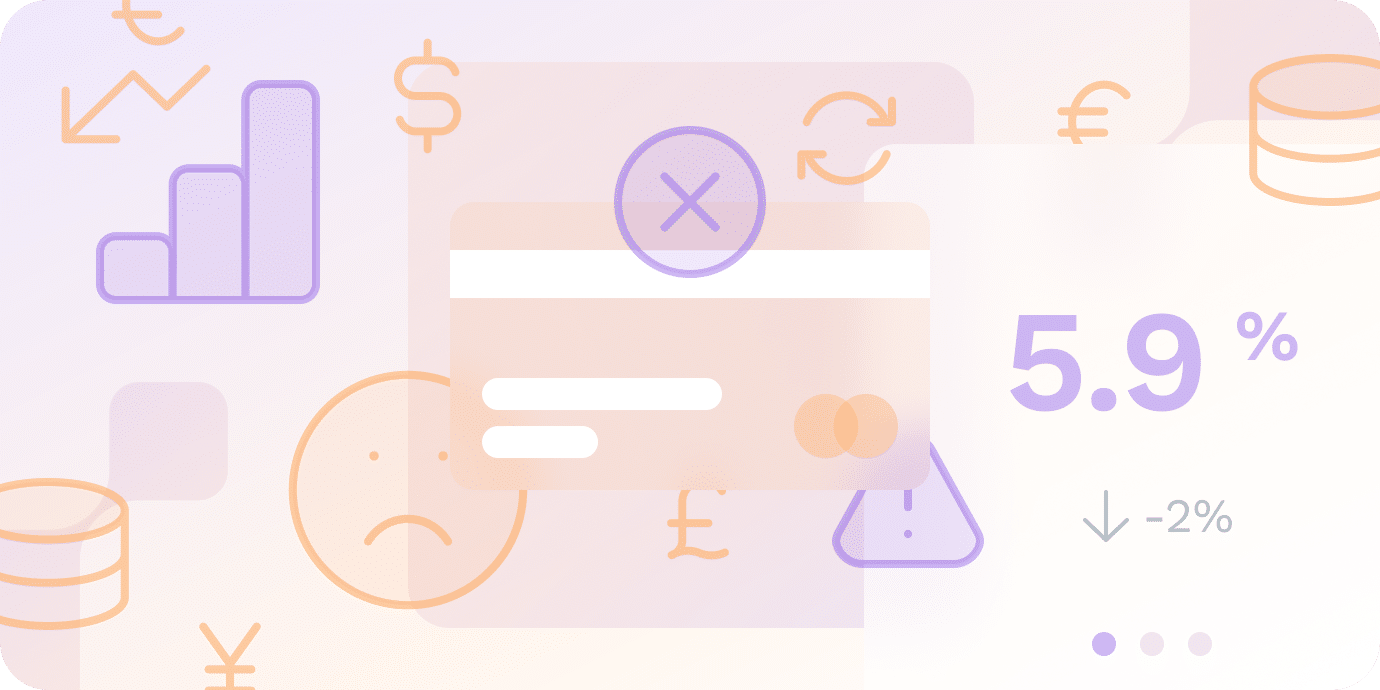SaaS 지표 및 KPI
비의적 이탈란 이란 무엇인가요?
게시일: 2025년 6월 26일

SaaS 비자발적 이탈이란 무엇일까요?
SaaS 비자발적 이탈은 반복 수익 구독을 의도치 않게 취소하는 고객의 비율입니다.
이는 결제 실패 또는 결제 정보 만료로 인해 고객이 모르는 사이에 자주 발생합니다.
고객이 의도적으로 구독을 취소하는 자발적 이탈과는 다릅니다. 비자발적 이탈은 일반적으로 제품 불만족을 반영하는 것이 아니라 결제 과정의 기술적 또는 재정적 문제를 반영하는 것입니다.
비자발적 이탈 vs. 자발적 이탈: 차이점은 무엇일까요?
자발적 이탈은 고객이 의식적으로 취소를 결정하는 것이지만, 비자발적 이탈은 지불 문제로 인해 의도치 않게 서비스가 손실되는 것입니다. NPS 점수와 리뷰에서 알 수 있듯이 불만족은 자발적 이탈의 주요 원인이 됩니다.
결제에 어려움을 겪는 만족한 고객도 비자발적 이탈을 경험할 수 있습니다.
각 유형의 이탈을 해결하려면 고객 경험 또는 결제 프로세스 개선에 중점을 둔 별도의 전략이 필요합니다.
비자발적 이탈은 SaaS 비즈니스에 어떤 영향을 미칩니까?
비자발적 이탈은 서비스에 대한 액세스 권한을 의도치 않게 잃은 만족한 소비자에게 영향을 미치므로 SaaS 조직에 상당한 매출 손실을 초래합니다. 구독 경제에서 전체 고객 이탈의 상당 부분(일반적으로 20~40%)을 차지하여 불필요한 매출 손실을 초래할 수 있습니다.
비자발적 이탈을 적극적으로 관리하면 고객 신뢰를 유지하고 결제 문제로 인한 서비스 중단으로 인한 적극적인 해지 가능성을 줄이는 데 도움이 됩니다.
SaaS 및 구독 서비스(전체 매출의 최대 30%를 차지할 수 있음)와 같이 반복 청구되는 산업은 제대로 통제되지 않을 경우 비자발적 이탈의 부정적인 영향에 특히 민감합니다.
비자발적 이탈을 포함한 이탈률은 어떻게 계산하나요?
관련 단계는 다음과 같습니다.
- 주어진 기간 동안 의도치 않게 이탈한 고객 수를 확인합니다.
- 다음으로, 동일 기간 시작 시점의 총 고객 수를 확인합니다.
- 비자발적 이탈 수를 시작 시점의 총 고객 수로 나누고 100을 곱하여 백분율을 계산합니다.
예를 들어, 회사가 1,000명의 고객으로 시작하여 20건의 비자발적 이탈이 발생한 경우, 비자발적 이탈률은 (20/1000)*100 = 2%입니다.
회사의 상태를 더욱 완전하게 파악하려면 고객 이탈률과 매출 이탈률을 구분해야 합니다.
비자발적 이탈의 원인은 무엇인가요?
SaaS에서 비자발적 이탈은 주로 결제 문제로 발생합니다. 구독 서비스 중단은 다음과 같은 이유로 발생할 수 있습니다.
- 결제 실패
- 신용 카드 만료
- 오래된 청구 정보
- 서버 오류
- 잔액 부족
다양한 결제 옵션을 제공하고 향후 결제 및 갱신에 대해 명확하게 소통하면 비자발적 이탈을 줄이는 데 도움이 됩니다.
비자발적 이탈을 방지하기 위해 SaaS 조직은 자동 알림 설정 및 대체 결제 수단 제공과 같은 결제 문제를 사전에 모니터링하고 해결해야 합니다.
비자발적 이탈에 대한 일반적인 오해는 무엇입니까?
비자발적 이탈이 주요 매출 문제가 아니며 대부분 불가피하다는 것은 흔한 오해입니다.
사실 비자발적 이탈은 결제 처리의 어려움으로 인해 발생하며, 그렇지 않으면 충성도가 높은 고객을 잃게 되는 피할 수 있는 손실로 이어집니다.
많은 기업들이 비자발적 이탈을 전체 매출의 1~2%에 불과하다고 생각하여 과소평가합니다. SaaS 기업은 효과적인 방법과 기술을 사용하여 비자발적 이탈을 줄이고 상당한 금액을 회수할 수 있습니다.
비자발적 이탈 방지를 위한 미래 트렌드는 무엇일까요?
SaaS 기업의 비자발적 이탈 방지를 위한 미래 트렌드는 다음과 같습니다.
- 스마트 독촉 및 개인화: 특정 결제 실패 이유와 고객 행동을 기반으로 AI 기반의 초개인화된 커뮤니케이션(이메일, SMS, 인앱)
- 고급 결제 조정: 지능형 재시도 로직, 자동 계정 업데이터 및 다양한 활용 결제 수단/게이트웨이를 통해 결제 성공률을 극대화합니다.
- 향상된 데이터 및 셀프 서비스: 고객이 결제 정보를 쉽게 업데이트할 수 있도록 실시간 분석을 통해 거절에 대한 인사이트와 사용자 친화적인 인앱 경험을 제공합니다.
- 선제적 참여: 잠재적 실패를 예측하고 실제 결제 거절이 발생하기 전에 고객의 참여를 유도합니다.
결론
결제 문제는 SaaS 기업에 상당한 매출 문제를 야기합니다.
기업은 스마트 독촉, 고급 결제 조정 및 향상된 데이터 활용과 같은 사전 예방 조치를 통해 원인을 파악하고, 비율을 정확하게 정량화하고, 일반적인 오해를 풀어 이 문제에 대처할 수 있습니다.
비자발적 이탈을 해결하면 매출을 절약할 뿐만 아니라 고객 신뢰와 충성도를 구축하여 경쟁이 치열한 SaaS 시장에서 장기적인 성공을 보장합니다.